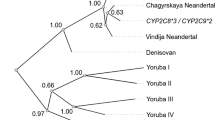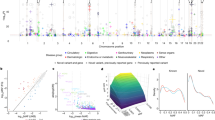Abstract
Cytochrome P450 2E1, gene symbol CYP2E1, is one of a family of enzymes with a central role in activating and detoxifying xenobiotics and endogenous compounds. Genetic variation at this gene has been reported in different human populations, and some association studies have reported increased risk for cancers and other diseases. To the best of our knowledge, multi-single-nucleotide polymorphism haplotypes and linkage disequilibrium (LD) have not been systematically studied for CYP2E1 in multiple populations. Haplotypes can greatly increase the power both to identify patterns of genetic variation relevant for gene expression as well as to detect disease-related susceptibility mutations. We present frequency and LD data and analyses for 11 polymorphisms and their haplotypes that we have studied on over 2600 individuals from 50 human population samples representing the major geographical regions of the world. The diverse patterns of haplotype variation found in the different populations we have studied show that ethnicity may be an important variable helping to explain inconsistencies that have been reported by association studies. More studies clearly are needed of the variants we have studied, especially those in the 5′ region, such as the variable number of tandem repeats, as well as studies of additional polymorphisms known for this gene to establish evidence relating any systematic differences in gene expression that exist to the haplotypes at this gene.
This is a preview of subscription content, access via your institution
Access options
Subscribe to this journal
Receive 6 print issues and online access
$259.00 per year
only $43.17 per issue
Buy this article
- Purchase on Springer Link
- Instant access to full article PDF
Prices may be subject to local taxes which are calculated during checkout





Similar content being viewed by others
Abbreviations
- CYP2E1 :
-
cytochrome P450, family 2, subfamily E, polypeptide 1
- LD:
-
linkage disequilibrium
- PCR:
-
polymerase chain reaction
- SNP:
-
single-nucleotide polymorphism
- UID:
-
unique identifier
- VNTR:
-
variable number of tandem repeats
References
Kidd KK, Morar B, Castiglione CM, Zhao H, Pakstis AJ, Speed WC et al. A global survey of haplotype frequencies and linkage disequilibrium at the DRD2 locus. Hum Genet 1998; 103: 211–227.
Kidd JR, Pakstis AJ, Zhao H, Lu RB, Okonofua FE, Odunsi A et al. Haplotypes and linkage disequilibrium at the phenylalanine hydroxylase locus, PAH, in a global representation of populations. Am J Hum Genet 2000; 66: 1882–1899.
Sawyer SL, Mukherjee N, Pakstis AJ, Feuk L, Kidd JR, Brookes AJ et al. Linkage disequilibrium patterns vary substantially among populations. Eur J Hum Genet 2005; 13: 677–686.
Frisse L, Hudson RR, Bartoszewicz A, Wall JD, Donfack J, Di Rienzo A . Gene conversion and different population histories may explain the contrast between polymorphism and linkage disequilibrium levels. Am J Hum Genet 2001; 69: 831–843.
Mukherjee N, Kidd KK, Pakstis AJ, Speed WC, Li H, Tarnok Z et al. The complex global pattern of genetic variation and linkage disequilibrium at catechol-O-methyl transferase (COMT). Mol Psychiatry 2008, advance online publication, 24 June 2008; doi: 10.1038/mp.2008.64.
Han Y, Gu S, Oota H, Osier MV, Pakstis AJ, Speed WC et al. Evidence of positive selection on a class I ADH locus. Am J Hum Genet 2007; 80: 441–456.
Tishkoff SA, Goldman A, Calafell F, Speed WC, Deinard AS, Bonne-Tamir B et al. A global haplotype analysis of the myotonic dystrophy locus: implications for the evolution of modern humans and for the origin of myotonic dystrophy mutations. Am J Hum Genet 1998; 62: 1389–1402.
Evans DM, Cardon LR . Guidelines for genotyping in genomewide linkage studies: single-nucleotide-polymorphism maps versus microsatellite maps. Am J Hum Genet 2004; 75: 687–692.
Gardner M, González-Neira A, Lao O, Calafell F, Bertranpetit J, Comas D . Extreme population differences across Neuregulin 1 gene, with implications for association studies. Mol Psychiatry 2006; 11: 66–75.
Niwa T, Inoue-Yamamoto S, Shiraga T, Takagi A . Effect of antifungal drugs on Cytochrome P450 (CYP) 1A2, CYP2D6, and CYP2E1 activities in human liver microsomes. Biol Pharm Bull 2005; 28: 1813–1816.
Peterson TC, Peterson MR, Wornell PA, Blanchard MG, Gonzalez FJ . Role of CYP1A2 and CYP2E1 in the pentoxifylline ciprofloxacin drug interaction. Biochem Pharmacol 2004; 68: 395–402.
Gonzalez FJ, Yu AM . Cytochrome P450 and xenobiotic receptor humanized mice. Ann Rev Pharmacol Toxicol 2006; 46: 41–64.
Hayashi S, Watanabe J, Nakachi K, Kawajiri K . Genetic linkage of lung cancer-associated MspI polymorphisms with amino acid replacement in the heme binding region of the human cytochrome P450IA1 gene. J Biochem (Tokyo) 1991; 110: 407–411.
Kim RB, Yamazaki H, Chiba K, O'Shea D, Mimura M, Guengerich FP et al. In vivo and in vitro characterization of CYP2E1 activity in Japanese and Caucasians. J Pharmacol Exp Ther 1996; 279: 4–11.
Garte S, Gaspari L, Alexandrie AK, Ambrosone C, Autrup H, Autrup JL et al. Metabolic gene polymorphism frequencies in control populations. Cancer Epidemiol Biomarkers Prev 2001; 10: 1239–1248.
Danko IM, Chaschin NA . Association of CYP2E1 gene polymorphism with predisposition to cancer development. Exp Oncol 2005; 27: 248–256.
Song BJ . Ethanol-inducible cytochrome P450 (CYP2E1): biochemistry, molecular biology and clinical relevance: 1996 update. Alcohol Clin Exp Res 1996; 20 (Suppl): 138A–146A.
Iwahashi HK, Ameno S, Ameno K, Okada N, Kinoshita H, Sakae Y et al. Relationship between alcoholism and CYP2E1 C/D polymorphism. Neuropsychobiology 1998; 38: 218–221.
Nguyen TT, Murphy NP, Austin CM . Amplification of multiple copies of mitochondrial Cytochrome b gene fragments in the Australian freshwater crayfish, Cherax destructor Clark (Parastacidae: Decapoda). Anim Genet 2002; 33: 304–308.
Howard LA, Ahluwalia JS, Lin SK, Sellers EM, Tyndale RF . CYP2E1*1D regulatory polymorphism: association with alcohol and nicotine dependence. Pharmacogenetics 2003; 13: 321–328. [erratum in Pharmacogenetics 2003; 13: 441–442].
Lee HS, Yoon JH, Kamimura S, Iwata K, Wataname H, Kim CY . Lack of association of cytochrome P4502 E1 genetic polymorphisms with the risk of human hepatocellular carcinoma. Int J Cancer 1997; 71: 737–740.
Morita S, Yano M, Shiozaki H, Tsujinaka T, Ebisui C, Morimoto T et al. eCYP1A1, CYP2E1 and GSTM1 polymorphisms are not associated with susceptibility to squamous-cell carcinoma of the esophagus. Int J Cancer 1997; 71: 192–195.
Powell H, Kitteringham NR, Pirmohamed M, Smith DA, Park BK . Expression of cytochrome P4502E1 in human liver: assessment by mRNA, genotype and phenotype. Pharmacogenetics 1998; 8: 411–421.
Wong NA, Rae F, Simpson KJ, Murray GD, Harrison DJ . Genetic polymorphisms of cytochrome p4502E1 and susceptibility to alcoholic liver disease and hepatocellular carcinoma in a white population: a study and literature review, including meta-analysis. Mol Pathol 2000; 53: 88–93.
Kidd KK, Pakstis AJ, Speed WC, Kidd JR . Understanding human DNA sequence variation. J Hered 2004; 95: 406–420.
Marsh S . Pharmacogenetics: global clinical markers. Pharmacogenomics 2008; 9: 371–373.
Redon R, Ishikawa S, Fitch KR, Feuk L, Perry GH, Andrews TD et al. Global variation in copy number in the human genome. Nature 2006; 444: 444–454.
Wang K, Li M, Hadley D, Liu R, Glessner J, Grant SF et al. PennCNV: an integrated hidden Markov model designed for high-resolution copy number variation detection in whole-genome SNP genotyping data. Genome Res 2007; 17: 1665–1674.
Hu Y, Hakkola J, Oscarson M, Ingelman-Sundberg M . Structural and functional characterization of the 5′-flanking region of the rat and human cytochrome P450 2E1 genes: identification of a polymorphic repeat in the human gene. Biochem Biophys Res Commun 1999; 263: 286–293.
Hawley ME, Kidd KK . HAPLO: a program using the EM algorithm to estimate the frequencies of multi-site haplotypes. J Hered 1995; 86: 409–411.
Devlin B, Risch N . A comparison of linkage disequilibrium measures for fine-scale mapping. Genomics 1995; 29: 311–322.
Lewontin RC . The interaction of selection and linkage. Ii. Optimum models. Genetics 1964; 50: 757–782.
Zhao H, Pakstis AJ, Kidd JR, Kidd KK . Assessing linkage disequilibrium in a complex genetic system. I. Overall deviation from random association. Ann Hum Genet 1999; 63: 167–179.
Gu S, Pakstis AJ, Kidd KK . HAPLOT: a graphical comparison of haplotype blocks, tagSNP sets and SNP variation for multiple populations. Bioinformatics 2005; 21: 3938–3939.
Acknowledgements
This work was funded, in part, by National Institute of Health grants GM057672 and AA009379 to Kenneth K Kidd. None of the authors has any conflicts of interest related to the data presented here. We thank all the colleagues who helped us assemble the population samples. Special thanks are due the many hundreds of individuals from these populations who volunteered to give blood samples for studies such as this.
Author information
Authors and Affiliations
Corresponding author
Additional information
Duality of interest
None declared.
Electronic databases cited
ALFRED, The ALlele FREquency Databse; http://alfred.med.yale.edu; PharmGKB, The Pharmacogenetics and Pharmacogenomics Knowledge Base, http://www.PharmGKB.org
Supplementary Information accompanies the paper on the The Pharmacogenomics Journal Web site (http://www.nature.com/tpj)
Rights and permissions
About this article
Cite this article
Lee, MY., Mukherjee, N., Pakstis, A. et al. Global patterns of variation in allele and haplotype frequencies and linkage disequilibrium across the CYP2E1 gene. Pharmacogenomics J 8, 349–356 (2008). https://doi.org/10.1038/tpj.2008.9
Received:
Revised:
Accepted:
Published:
Issue Date:
DOI: https://doi.org/10.1038/tpj.2008.9
Keywords
This article is cited by
-
Proposed nomenclature for microhaplotypes
Human Genomics (2016)
-
Mini-haplotypes as lineage informative SNPs and ancestry inference SNPs
European Journal of Human Genetics (2012)
-
Global variation in CYP2C8–CYP2C9 functional haplotypes
The Pharmacogenomics Journal (2009)



